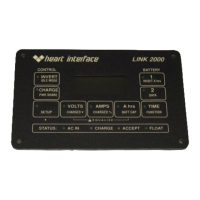5/31/96
17
over-charge Ahrs. When discharging begins, over-charge Ahrs are erased and the LINK 2000
resets to zero.
Systems that have a Conditioning or Equalization cycle will accumulate a few over-
charge A hrs during equalization. This is normal and ensures that the LINK 2000 stays in sync
with the battery state of charge.
BATTERY CAPACITY TESTING
Your LINK 2000 Meter can be used to conduct periodic capacity tests that tell you the
actual amount of energy your batteries can store. A capacity test should start with a battery
that has been properly charged and conditioned. The objective is to find the maximum available
capacity.
Deep cycle battery capacity is usually stated as a 20 hour discharge rate. A 100 A hr
battery will provide 5 amps for 20 hours. At discharge rates above 5 amps, the battery will not
supply 100 A hr. For example: If you are drawing 100 amps out of the battery it will last less
than one half hour. This was discovered in 1897 by a scientist named Peukert and is
discussed in detail later. You can see the effect in the following table listing approximate
capacities at different discharge rates.
CAPACITY AT VARIOUS DISCHARGE RATES
(percentage of 20 hour rate)
Hours to Discharge Capacity (percent of rating)
20 100%
10 89%
5 78%
3 66%
1 45%
To test battery capacity, turn on a load that draws approximately 5% of the declared
battery capacity. Measure the current using the Amps function of the Link 2000. The load
should be constant, such as incandescent lighting. When the battery voltage reaches 10.5
volts, hopefully about 20 hours later, turn off the load and look at the A hrs display on your LINK
2000. The number displayed is the capacity at the test current. If less than 20 hours passed before
the battery voltage fell to 10.5V you can still determine the capacity with some arithmetic. For
example: Assume a 12V battery rated at 100 A hr. Apply a 5 amp load. Suppose it only took
10 hours for the voltage to reach 10.50 volts. LINK 2000 would display -50 A hr. This is
the 10 hour capacity. Dividing 50 by 89% (10 hour rate) from the table above, you determine
that the actual 20 hour capacity is 56 Amp-hours. You could repeat the test at 5% of the tested
capacity (2.8A) to verify the actual capacity.
USING YOUR INVERTER
TO TEST BATTERY CAPACITY
Your inverter makes testing the battery capacity easy. First fully charge ( and
equalize if necessary) the battery to be tested. Use a load like incandescent lights running on the
inverter whose amperage consumption is 5% or less of the battery capacity. Let the load run until
the inverter shuts down on low voltage (about 10.2V). Read the number of Amp-hours that have
been consumed from the battery. If it is not close to the expected number use the procedure
outlined above to estimate the capacity.
Caution! Be sure to completely recharge your battery after a discharge test.

